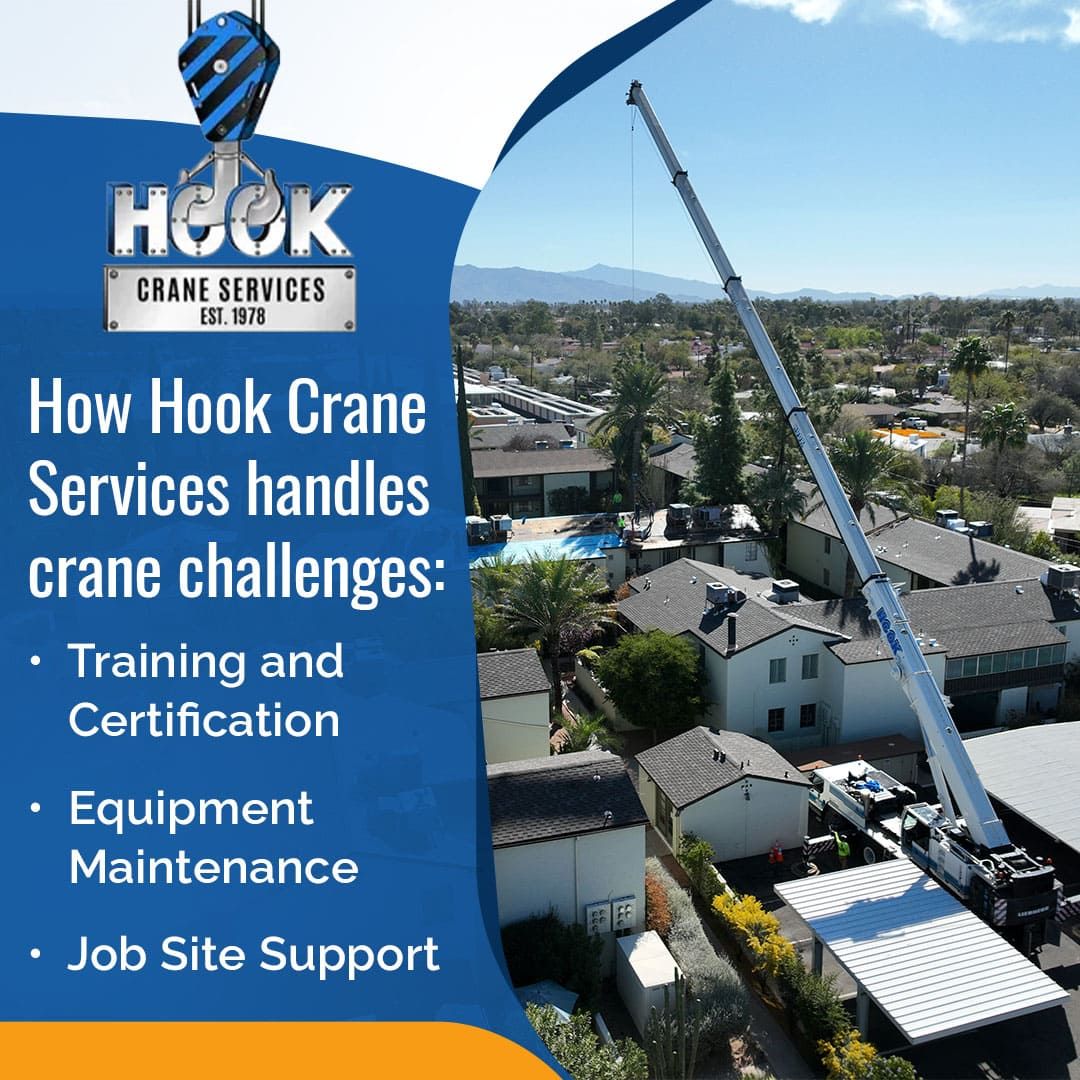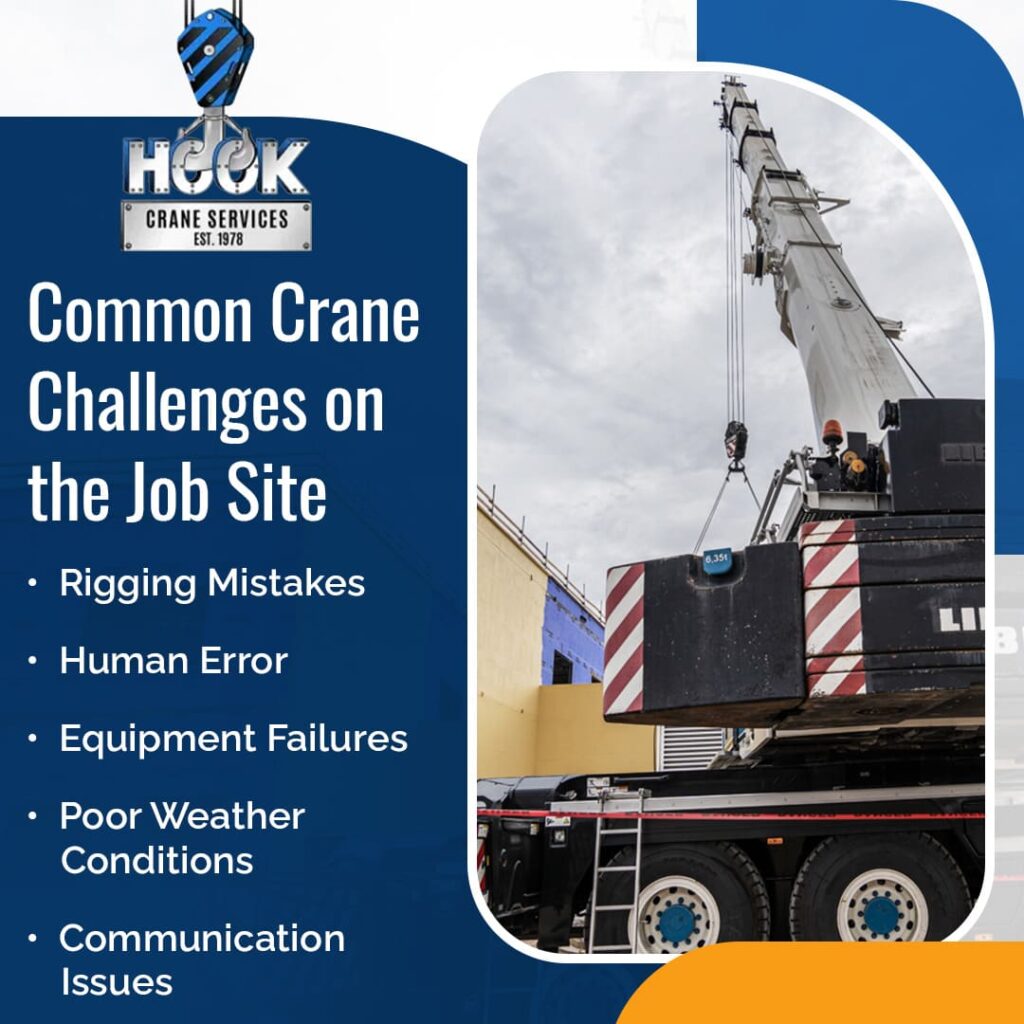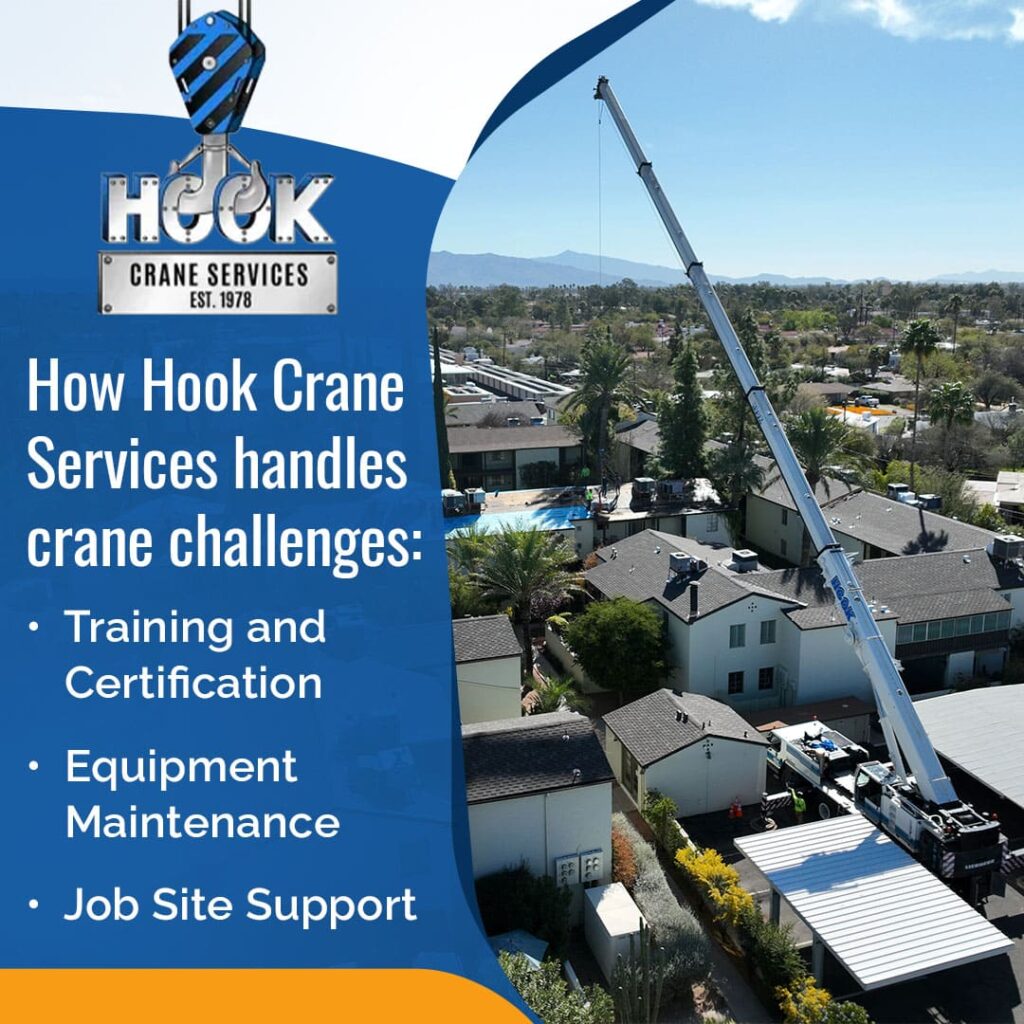
Crane Service Best Practices: Identifying and Mitigating Common Operation Hazards
Crane operations come with serious risks, from equipment failure to rigging mistakes, but many incidents are preventable with the right strategies in place. This blog outlines common crane-related hazards and how Hook Crane Services addresses them through proper training, routine maintenance, weather planning, and clear communication. Real-world examples from Tucson-area projects highlight how proactive decision-making helps us protect crews, clients, and timelines—every time we lift.
Key Takeaways
- Proper rigging prevents load shifts – Incorrect rigging can lead to severe accidents, but trained crews and regular inspections help prevent them.
- Operator training reduces human error – Skilled, well-prepared operators are less likely to make costly or dangerous mistakes.
- Routine equipment checks avoid failures – Ongoing maintenance and early issue detection can keep projects on track and safe.
- Weather awareness protects crews and timelines – Monitoring and adjusting for conditions like wind ascertains safety and project continuity.
- Clear communication boosts site coordination – Using standard protocols and trained signalers minimizes misunderstandings during lifts.
Crane operations are the backbone of heavy construction, but when something goes wrong, the consequences can be devastating. At Hook Crane Services – Crane Rental, safety isn’t just a priority; it’s a promise. Every lift, every load, and every move demands precision, training, and constant vigilance. According to OSHA, crane-related incidents remain one of the leading causes of injuries and fatalities in construction, making it critical to address risks before they turn into tragedies.
In Tucson, AZ, where construction sites face everything from blistering heat to complex terrain, staying ahead of these challenges requires more than just good intentions—it demands best-in-class practices. By investing in operator training, proactive equipment maintenance, and clear on-site protocols, contractors can turn risk into reliability. These proven strategies not only protect workers but also boost efficiency and keep projects on track.
At the heart of it all is a commitment to creating safer, more productive sites. When crane service companies lead with safety, the entire construction process becomes stronger from the ground up.

Common Crane Operation Issues
As a team that places a high value on safety and efficiency in crane operations, we have encountered various typical issues that can compromise the well-being of workers and the success of operations. These issues are not just potential setbacks; they carry the risk of serious accidents and operational delays if not properly managed. Below are some of these common issues:
1. Improper Rigging Practices
One of the most serious risks in crane operations begins before the lift, at the rigging (securing loads to cranes with slings or gear) point. Incorrect setup can cause loads to shift, drop, or swing out of control. Using the wrong slings, overloading hardware, or misjudging weight distribution increases the chance of accidents.
To reduce these risks, teams should be trained to assess each load and select the right equipment for the job. Routine checks for worn or damaged rigging gear are just as important. Following the National Commission for the Certification of Crane Operators (NCCCO) guidelines help crews stay aligned on safety expectations. With the right knowledge and inspections in place, teams can confidently secure each lift and focus on execution.
2. Operator Error
Even the best equipment is only as safe as the person behind the controls. Rushed decisions, poor load estimates, or unfamiliarity with crane limits can turn routine lifts into dangerous situations.
Real-world training makes a difference. Operators benefit most from hands-on learning, especially through simulators that mimic job site challenges. Regular refreshers help keep best practices top-of-mind and allow operators to stay current with regulations and techniques. Clear communication and a safety-first mindset empower operators to speak up and avoid avoidable risks.
3. Equipment Failure
Cranes work under intense pressure. When maintenance is overlooked, parts wear down, and systems fail. The result can be a halted job or, worse, a preventable accident.
A proactive maintenance schedule should track inspections, repairs, and parts replacement. Monitoring systems offer a deeper look into equipment performance, alerting crews to problems before they escalate. Operators should be encouraged to report unusual sounds, vibrations, or slow responses, as these are often the initial signs of mechanical trouble. Shared responsibility across the team helps keep machines running safely and reliably.
4. Adverse Weather Conditions
Sudden gusts of wind, lightning, and heavy rain can bring operations to a stop or tempt crews to take dangerous shortcuts. Weather affects visibility, load stability, and control, all of which increase risk.
Planning around forecasted conditions is non-negotiable. Teams should follow clear weather protocols, including thresholds for wind speed and site shutdowns. Real-time monitoring apps and radar tools help crews stay ahead of incoming storms. Training workers to respond quickly when conditions shift adds another layer of safety and prevents rushed decisions under pressure.
5. Inadequate Communication
When instructions aren’t heard or aren’t clear, mistakes happen. Crane lifts require precise coordination. A single misunderstanding between a signaler (trained crew guiding lifts with hand signals or radios) and an operator can lead to chaos on the ground.
Establishing standard communication protocols keeps everyone aligned. Hand signals, radios, and designated signalers help maintain consistency, especially in loud or busy environments. Pre-lift meetings clarify roles and expectations, while ongoing communication reinforces trust throughout the job. The stronger the coordination, the smoother and safer the lift.
When safety leads the conversation, performance follows. At Hook Crane Services, spotting and solving these common hazards is the foundation of successful projects and safer worksites.
Addressing Crane Operation Issues at Hook Crane Services
Since 1978, Hook Crane Services has been dedicated to raising the bar for safety and performance as a leading crane services company. Headquartered in Tucson, Arizona, we’ve evolved from a small local team into a trusted name with a modern fleet and a strong presence across the region. Safety isn’t just a policy; it’s part of our identity. With every project, we focus on refining our practices to protect crews, equipment, and timelines.
Our Services
We offer a variety of crane services aimed at both residential and commercial clients. Our services include:
- Crane Operations: We provide professional crane operations for construction and logistics, ensuring tasks are executed safely and effectively.
- 24-Hour Emergency Services: We are available around the clock to respond to any urgent crane needs.
- Rigging Support: Our professional rigging team makes sure that every lift is performed safely, adhering to OSHA and NIOSH guidelines.
Quality Control and Safety Procedures
As a dedicated crane service company, maintaining high standards in safety and quality control is paramount. We implement the following procedures to mitigate the issues mentioned earlier:
- Regular training sessions for crane operators and crew members.
- A safety supervisor on-site to monitor operations.
- Detailed pre-lift inspections of equipment and loading capabilities.

Fleet Information
Our fleet includes a variety of cranes with different capacities and boom (crane’s extendable lifting arm) lengths suitable for various tasks. For example:
- 17 Ton Boom Truck: Ideal for smaller jobs requiring precision.
- 90 Ton Crane with 201′ Boom & Jib: Suitable for larger projects needing heavy lifting capabilities.
- 165 Ton Crane with 260′ Boom & Jib: Best for substantial municipal projects.
We ascertain that our cranes are routinely serviced to minimize the risk of mechanical failure.
Training and Development Support
Training is not just about operating the crane; it’s about instilling safety practices that prevent common issues. Our training programs include:
- Certification courses for operators through the NCCCO.
- Rigging and signaling training for all crew members.
- Emergency response drills to prepare the team for unexpected situations.
The Role of Certifications in Safe Crane Operations
Certified operators bring confidence and control to every lift. As a trusted crane services company, Hook Crane Services sees certification not as a checkbox but as a vital layer of protection. Through rigorous training programs, our team is prepared to meet the demands of any project while upholding the safety protocols that keep every job site running smoothly and securely.
How We Support Our Clients
At Hook Crane Services, we go beyond merely providing crane services. We try hard to ease the entire process for our clients by offering the following:
- Consultation: Providing advice on the type of crane service required for specific projects.
- Logistic Support: Assisting with transportation and placement of cranes at job sites.
- Continuous Communication: Keeping clients informed throughout the project lifecycle to provide transparency.
Area of Operations
We have built our reputation throughout Southern Arizona, serving locations such as:
- Tucson: Where our operations began.
- Catalina Foothills: Catering to various residential projects.
- Green Valley: Supporting commercial developments with our fleet.
- Marana and Oro Valley: Offering vital crane services for local construction needs.
Real-World Examples of Mitigation Strategies
Here are a couple of real-world examples where we successfully addressed crane operation challenges on the job sites:
Pedestrian Bridge Installation – Load Stability Adjustment
While setting a pedestrian bridge, our crew identified a shift in load balance during the initial lift. Instead of proceeding, we paused the operation, re-evaluated the rigging setup, and adjusted the lift points to stabilize the load. The bridge was successfully placed with no delays or safety concerns, demonstrating the importance of staying alert and adaptable on the job.
Recovering a Tipped Forward Reach Forklift
During a project at a site, we were called in to lift a forward-reach forklift that had tipped over. Our team assessed the weight, chose the right crane and rigging gear, and safely uprighted the equipment without causing further damage. The operation was completed quickly, allowing the site to resume normal activity with minimal disruption.
Statistics and Data on Crane Operations
- Based on the U.S. Bureau of Labor Statistics (BLS) report, crane-related workplace deaths have steadily declined over the years. In 2017, there were 33 fatal occupational injuries involving cranes, the lowest number recorded since the BLS began tracking this data in 1992. Between 2011 and 2017, an average of 42 crane-related fatalities occurred each year. This downward trend reflects ongoing improvements in safety standards and awareness around crane operations in the construction and manufacturing industries. Despite the progress, crane-related work remains high-risk, reinforcing the need for strict safety practices and proper operator training.
- The National Safety Council (NSC) report states that proper training of crane operators can reduce accidents by 80%. However, a study conducted by Cal/OSHA indicates that implementing crane operator certification led to a significant 80% decrease in crane-related fatalities in California. This demonstrates the critical importance of extensive training programs in enhancing workplace safety.
A Safer Way to Lift Every Time
Crane operations come with risks, but with the right approach, those risks don’t have to become setbacks. At Hook Crane Services, based in Tucson, Arizona, we focus on smart planning, skilled operators, and well-maintained equipment to keep every job running safely and smoothly. Our team doesn’t just show up with a crane; we bring a safety-first mindset to every lift, no matter the size.
Whether you’re lifting HVAC units, recovering equipment, or placing a pedestrian bridge, we’re ready to help get the job done right. Let’s raise the standard together—reach out to Hook Crane Services and see how safety drives everything we do.
Contact Us
For more information about our crane services or to request a quote, please get in touch with us at (520) 323-0963 or hookcrane@hookcrane.com.
Let us assist you in making your next project a success. Together, we can achieve a safer and more efficient worksite for everyone involved.